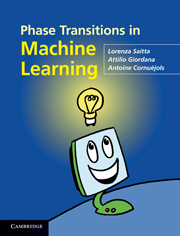Book contents
- Frontmatter
- Contents
- Preface
- Acknowledgments
- Notation
- 1 Introduction
- 2 Statistical physics and phase transitions
- 3 The satisfiability problem
- 4 Constraint satisfaction problems
- 5 Machine learning
- 6 Searching the hypothesis space
- 7 Statistical physics and machine learning
- 8 Learning, SAT, and CSP
- 9 Phase transition in FOL covering test
- 10 Phase transitions and relational learning
- 11 Phase transitions in grammatical inference
- 12 Phase transitions in complex systems
- 13 Phase transitions in natural systems
- 14 Discussion and open issues
- Appendix A Phase transitions detected in two real cases
- Appendix B An intriguing idea
- References
- Index
3 - The satisfiability problem
Published online by Cambridge University Press: 05 August 2012
- Frontmatter
- Contents
- Preface
- Acknowledgments
- Notation
- 1 Introduction
- 2 Statistical physics and phase transitions
- 3 The satisfiability problem
- 4 Constraint satisfaction problems
- 5 Machine learning
- 6 Searching the hypothesis space
- 7 Statistical physics and machine learning
- 8 Learning, SAT, and CSP
- 9 Phase transition in FOL covering test
- 10 Phase transitions and relational learning
- 11 Phase transitions in grammatical inference
- 12 Phase transitions in complex systems
- 13 Phase transitions in natural systems
- 14 Discussion and open issues
- Appendix A Phase transitions detected in two real cases
- Appendix B An intriguing idea
- References
- Index
Summary
General framework
Surprising as it may be, the emergence of phase transitions is not limited to physical systems: it seems to be a rather ubiquitous phenomenon, existing in biology, genetics, neural networks, complex systems, and also in combinatorial problems. For the last, a precise parallel can be established with physical systems composed of very large numbers of particles. In a combinatorial problem the phase transition concerns the behavior of some order parameter (usually the expectation value of a microscopic quantity) characterizing an aspect of the system (often the probability of existence of a solution). Moreover, in correspondence to the phase transition (at a critical value of the control parameter), a large increase in the computational complexity of the algorithm used to find a solution is usually observed.
The key concept that allows ideas and methods to be transferred from statistical physics to combinatorial optimization and decision problems is randomness. If problem instances are taken in isolation, the application of these methods does not make sense. They are only meaningful if applied to a set, i.e., an ensemble, of problem instances whose probability of occurrence is governed by a well defined law. Then the results obtained can be considered valid for any randomly extracted element from the ensemble. It is thus necessary to specify exactly how the elements of the ensemble are constructed.
- Type
- Chapter
- Information
- Phase Transitions in Machine Learning , pp. 43 - 69Publisher: Cambridge University PressPrint publication year: 2011



